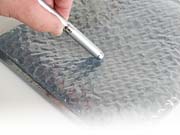Security Ink Battles Product Counterfeiting
Product counterfeiting of lower quality look-alikes is not flattering: it creates brand erosion and loss of brand equity through loss of customer base. Long-term customers often believe their trusted brand has declined in quality because - unknowingly - the customer is using a counterfeit product that was manufactured with lower-cost ingredients. The packaging of these look-a-likes is nearly identical, so the average consumer does not notice the difference when purchasing the item. Many high-value items - consumer and retail product brands, garments, tobacco and alcohol products, and pharmaceuticals - are at risk of counterfeiting. New innovations in desktop computing make producing convincing fakes cheaper and easier than ever before.
When a customer no longer trusts the brand, they no longer purchase the product. Aside from siphoning revenue and diluting profits, brand theft can potentially instigate liability issues, resulting in legal proceedings if the product inside the package has been altered, switched or counterfeited.
Gray-market diversion is another costly problem for consumer product companies. The official manufactured brand product is sold at different price points within different geographical areas. Frequently, the product destined for the lower-price market is discovered back in the higher-price market, having been diverted by distribution pirates and wholesalers, acting against their contractual obligations to the consumer product company.

An Invisible Weapon
How can the paint industry fight the counterfeiting battle? Most consumer products, pharmaceutical and cosmetics companies attempt to detect counterfeit products and to track and trace individual products to prevent these kinds of losses. Overt solutions for security and authentication are detectable by sight or touch, such as holograms and intaglio printing. Since these solutions are visible, they can be easily identified by counterfeiters, and can be copied with relative ease using available technologies.Creo Inc., a subsidiary of Kodak and renowned for imaging technology, is developing a new invisible identification and brand authentication technology that could provide manufacturers with low-cost protection against counterfeiting.
The Traceless™ marking and sensing system incorporates a new patents-pending technology that allows the creation of unique, forensically invisible identification codes. These codes can be used for anti-counterfeiting, inventory management, product tracking and tracing, or brand authentication.

Consumer goods can all be protected with this new system. Traceless security brand authentication and identification systems mark items or materials invisibly and uniquely. This creates track and trace functionality that is superior to bar codes, DNA, scrambled indicia, MICR, magnetic inks, machine-readable characters, and radio frequency identification (RFID). Indicia is the prepaid marking on each piece of a bulk mailing that shows that postage has been paid by the sender. Traceless provides significantly more security than these systems at a fraction of the cost.
Since Traceless uses the optically and forensically invisible taggant particles, each package or label is uniquely identified through the random particle positioning. These patterns or signatures are unrepeatable and create a unique ‘fingerprint' for each product. The taggants can be added to printing inks, copier and printer toners, varnishes, sprays, powders, paints, glass, building materials, moulded or extruded plastics, molten metals, fuels, fertilizers and explosives, as well as paper, pulp or woven fibres.

Another application incorporates Traceless taggants into the world's first security ink for high-volume flexographic radio frequency identification (RFID) antenna production. One of the main concerns of the RFID industry has been the ability of counterfeiters to copy RFID tags by duplicating RFID numbering schemes. The new antenna inks developed by XINK Laboratories Ltd. of Ottawa, Canada, eliminate this possibility by integrating Traceless tagging technology. The forensically invisible taggant can be detected using Creo readers on high-speed manufacturing lines at up to 100 reads per second (360,000 items per hour).

"Traceless systems can even go further, using the pure randomness of taggant particle positioning to designate each item uniquely, like a fingerprint," said Kevin Harrell, director of global business development for Kodak's Graphic Communications Group.
"This taggant image signature is the ultimate in product brand authentication. Imagine having every product uniquely identified, with the database accessible exclusively to the brand goods company."
To learn more about Traceless, contact Kevin Harrell 630/775.7741, e-mail Kevin.Harrell@Creo.com or visit www.kodak.com/go/traceless.
Looking for a reprint of this article?
From high-res PDFs to custom plaques, order your copy today!




